Essential Big Links Carrara 11"X11"
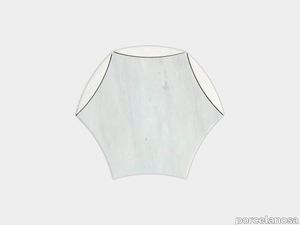
porcelanosa > Wall tile-stone-brick
Matt white stone mosaic. Size 11 x 11 in. Suitable for interior wall/floor and shower wall/floor.
Dip Mix 12"X12"
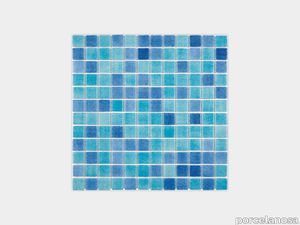
porcelanosa > Wall tile-stone-brick
Gloss glass blue mosaic. Size 12 x 12 in. Suitable for interior wall/floor, exterior wall, pools and shower wall.
Dip Medium 12"X12"
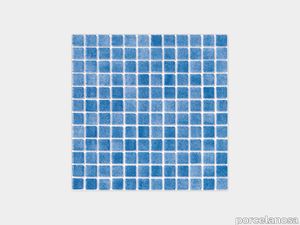
porcelanosa > Wall tile-stone-brick
Gloss glass blue mosaic. Size 12 x 12 in. Suitable for interior wall/floor, exterior wall, pools and shower wall.
Dip Light 12"X12"
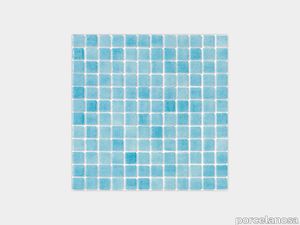
porcelanosa > Wall tile-stone-brick
Gloss glass blue mosaic. Size 12 x 12 in. Suitable for interior wall/floor, exterior wall, pools and shower wall.
Dip Dark 12"X12"
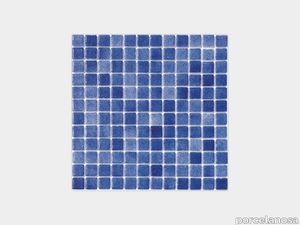
porcelanosa > Wall tile-stone-brick
Gloss glass blue mosaic. Size 12 x 12 in. Suitable for interior wall/floor, exterior wall, pools and shower wall.
Boulder Negro Marquina 12"X12"
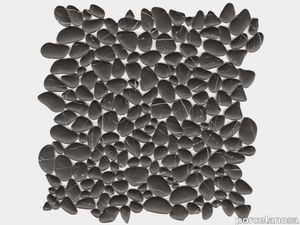
porcelanosa > Wall tile-stone-brick
Matt black 3D glass mosaic. Size 12 x 12 in. Suitable for interior wall/floor, exterior wall and shower wall/floor.
Boulder Grey 12"X12"
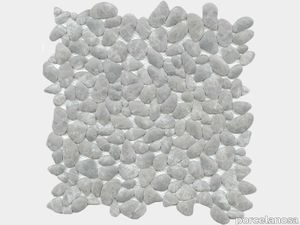
porcelanosa > Wall tile-stone-brick
Boulder Grey 12"X12" - MosaicThe Boulder Grey 12"X12" Mosaic by L'Antic Colonial is the perfect addition to any bathroom, kitchen, living room, bedroom, or outdoor space. Featuring an elegant grey glass mosaic with a subtle matt finish, this tile creates a stunning visual effect while standing up to the wear and tear of everyday use. With its classic design, this durable and practical tile provides the perfect combination of function and style. Whether you want to add a touch of modern flair to your living room or brighten up your bathroom, the Boulder Grey 12"X12" Mosaic is an excellent choice.
Boulder Carrara 12"X12"
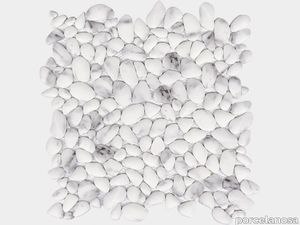
porcelanosa > Wall tile-stone-brick
Boulder Carrara 12"X12" - MosaicIntroducing the Boulder Carrara 12"X12" Mosaic from L'Antic Colonial, a classic and timeless product to spruce up any living space. The Mosaic is crafted using glass in a white color with a matte finish, and boasts a contemporary look that is both modern and functional. This Mosaic is perfect for a wide range of applications, from your kitchen to your bathroom, from your living room to your bedroom, and even outside; the possibilities are virtually endless. The Mosaic itself is simple yet highly functional, with its 12"X12" size and beautiful white color, it is sure to give any room a classy, luxurious, and timeless touch. Using the highest quality and unique materials, the Boulder Carrara 12"X12" Mosaic is sure to provide you with years of durability and charm, as well as a modern touch that will make any room stand out. With its timeless, modern look, you can be sure that the Boulder Carrara Mosaic will be a perfect addition to any home. No matter where the Mosaic is installed, it is sure to provide a sense of sophistication and charm.
Boulder Beige 12"X12"
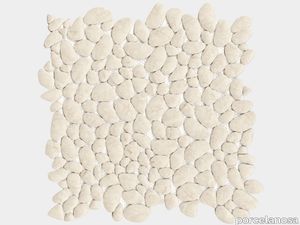
porcelanosa > Wall tile-stone-brick
Matt beige 3D glass mosaic. Size 12 x 12 in. Suitable for interior wall/floor, exterior wall and shower wall/floor.
Airtech London_Black
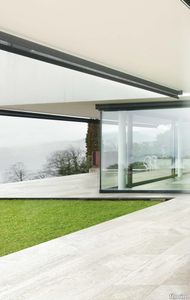
florim > Wall tile-stone-brick
Airtech/ is a collection designed to create spaces that interact with each other in a uniform and discreet manner. <p>The collection offers six stones available in shades of gray, the quintessential metropolitan color. The 60x120 cm size with a high-gloss finish gives a bright and appealing nuance to this very austere project. There are two available thicknesses, 9 mm and 20 mm.</p>
Airtech Berlin_Red

florim > Wall tile-stone-brick
Airtech/ is a collection designed to create spaces that interact with each other in a uniform and discreet manner. <p>The collection offers six stones available in shades of gray, the quintessential metropolitan color. The 60x120 cm size with a high-gloss finish gives a bright and appealing nuance to this very austere project. There are two available thicknesses, 9 mm and 20 mm.</p>
Airtech Basel_Grey

florim > Wall tile-stone-brick
Airtech/ is a collection designed to create spaces that interact with each other in a uniform and discreet manner. <p>The collection offers six stones available in shades of gray, the quintessential metropolitan color. The 60x120 cm size with a high-gloss finish gives a bright and appealing nuance to this very austere project. There are two available thicknesses, 9 mm and 20 mm.</p>
Airtech New York_Light Grey

florim > Wall tile-stone-brick
Airtech/ is a collection designed to create spaces that interact with each other in a uniform and discreet manner. <p>The collection offers six stones available in shades of gray, the quintessential metropolitan color. The 60x120 cm size with a high-gloss finish gives a bright and appealing nuance to this very austere project. There are two available thicknesses, 9 mm and 20 mm.</p>
Airtech Stockholm_Greige

florim > Wall tile-stone-brick
Airtech/ is a collection designed to create spaces that interact with each other in a uniform and discreet manner. <p>The collection offers six stones available in shades of gray, the quintessential metropolitan color. The 60x120 cm size with a high-gloss finish gives a bright and appealing nuance to this very austere project. There are two available thicknesses, 9 mm and 20 mm.</p>
Airtech MIAMI WHITE

florim > Wall tile-stone-brick
Airtech/ is a collection designed to create spaces that interact with each other in a uniform and discreet manner. <p>The collection offers six stones available in shades of gray, the quintessential metropolitan color. The 60x120 cm size with a high-gloss finish gives a bright and appealing nuance to this very austere project. There are two available thicknesses, 9 mm and 20 mm.</p>
Antique Marble Pantheon Marble_06

florim > Wall tile-stone-brick
Six essences inspired by the beauty of marble become stylistic shades to create modern and functional environments The collection is available in various finishes and sizes suitable for private spaces and the light commercial world with shades that go from white to beige, from grey to desaturated black.
Antique Marble Ghost Marble_01

florim > Wall tile-stone-brick
Six essences inspired by the beauty of marble become stylistic shades to create modern and functional environments The collection is available in various finishes and sizes suitable for private spaces and the light commercial world with shades that go from white to beige, from grey to desaturated black.
Antique Marble Pure Marble_02

florim > Wall tile-stone-brick
Six essences inspired by the beauty of marble become stylistic shades to create modern and functional environments The collection is available in various finishes and sizes suitable for private spaces and the light commercial world with shades that go from white to beige, from grey to desaturated black.
Antique Marble Imperial Marble_04

florim > Wall tile-stone-brick
Six essences inspired by the beauty of marble become stylistic shades to create modern and functional environments The collection is available in various finishes and sizes suitable for private spaces and the light commercial world with shades that go from white to beige, from grey to desaturated black.
Ardoise Plomb
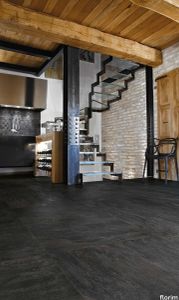
florim > Wall tile-stone-brick
A timeless material whose authenticity, sensual and elegant, is implemented in modern environments, where precious and recovered elements coexist in perfect harmony. <p>A precise chromatic choice selected 6 neutral and modern shades that cater to the vivid texture, the absolute protagonist of the collection. The delicacy of the colors chosen give the space a strong sense of light that contrasts with the hardness of the stone. The experience of Florim manages to join three dimensional texture and graphic movements in a play of optical effects to make a timeless material modern, giving it new life.</p>
Ardoise Ivoire

florim > Wall tile-stone-brick
A timeless material whose authenticity, sensual and elegant, is implemented in modern environments, where precious and recovered elements coexist in perfect harmony. <p>A precise chromatic choice selected 6 neutral and modern shades that cater to the vivid texture, the absolute protagonist of the collection. The delicacy of the colors chosen give the space a strong sense of light that contrasts with the hardness of the stone. The experience of Florim manages to join three dimensional texture and graphic movements in a play of optical effects to make a timeless material modern, giving it new life.</p>
Atmosphères Mystère
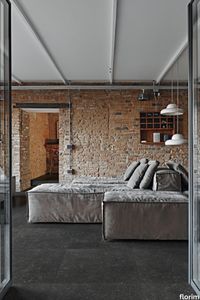
florim > Wall tile-stone-brick
A collection of profound and mesmerising energy which conveys all the informal elegance of luxurious contemporary spaces Lightness and solidity, combined with a sophisticated colour scheme, evoke the sense of craftsmanship associated with this wonderful stone whose stratified fossils, trapped in the slender sediments formed over the centuries, embody its time-honoured yet contemporary beauty. Tradition and innovation therefore come together in a unique project, creating an attractive surface that respects the culture of places and the history of time.
Atmosphères Désir

florim > Wall tile-stone-brick
A collection of profound and mesmerising energy which conveys all the informal elegance of luxurious contemporary spaces Lightness and solidity, combined with a sophisticated colour scheme, evoke the sense of craftsmanship associated with this wonderful stone whose stratified fossils, trapped in the slender sediments formed over the centuries, embody its time-honoured yet contemporary beauty. Tradition and innovation therefore come together in a unique project, creating an attractive surface that respects the culture of places and the history of time.
Atmosphères Aurore

florim > Wall tile-stone-brick
A collection of profound and mesmerising energy which conveys all the informal elegance of luxurious contemporary spaces Lightness and solidity, combined with a sophisticated colour scheme, evoke the sense of craftsmanship associated with this wonderful stone whose stratified fossils, trapped in the slender sediments formed over the centuries, embody its time-honoured yet contemporary beauty. Tradition and innovation therefore come together in a unique project, creating an attractive surface that respects the culture of places and the history of time.
Atmosphères Lumière

florim > Wall tile-stone-brick
A collection of profound and mesmerising energy which conveys all the informal elegance of luxurious contemporary spaces Lightness and solidity, combined with a sophisticated colour scheme, evoke the sense of craftsmanship associated with this wonderful stone whose stratified fossils, trapped in the slender sediments formed over the centuries, embody its time-honoured yet contemporary beauty. Tradition and innovation therefore come together in a unique project, creating an attractive surface that respects the culture of places and the history of time.
Atmosphères Charme

florim > Wall tile-stone-brick
A collection of profound and mesmerising energy which conveys all the informal elegance of luxurious contemporary spaces Lightness and solidity, combined with a sophisticated colour scheme, evoke the sense of craftsmanship associated with this wonderful stone whose stratified fossils, trapped in the slender sediments formed over the centuries, embody its time-honoured yet contemporary beauty. Tradition and innovation therefore come together in a unique project, creating an attractive surface that respects the culture of places and the history of time.
Atmosphères Ombre

florim > Wall tile-stone-brick
A collection of profound and mesmerising energy which conveys all the informal elegance of luxurious contemporary spaces Lightness and solidity, combined with a sophisticated colour scheme, evoke the sense of craftsmanship associated with this wonderful stone whose stratified fossils, trapped in the slender sediments formed over the centuries, embody its time-honoured yet contemporary beauty. Tradition and innovation therefore come together in a unique project, creating an attractive surface that respects the culture of places and the history of time.
Atmosphères Harmonie

florim > Wall tile-stone-brick
A collection of profound and mesmerising energy which conveys all the informal elegance of luxurious contemporary spaces Lightness and solidity, combined with a sophisticated colour scheme, evoke the sense of craftsmanship associated with this wonderful stone whose stratified fossils, trapped in the slender sediments formed over the centuries, embody its time-honoured yet contemporary beauty. Tradition and innovation therefore come together in a unique project, creating an attractive surface that respects the culture of places and the history of time.
Biotech Soap Stone
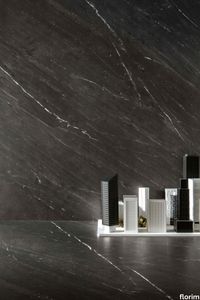
florim > Wall tile-stone-brick
<p>The Biotech collection by Florim embraces the principles of sustainable architecture. </p> <p>The collection is born from a sustainable and virtuous approach and is part of <a href="https://www.florim.com/en/company/sustainability/carbonzero-florim/">CarbonZero</a>, Florim's range of Carbon Neutral surfaces.</p> <p><br>Florim provides the scope to contribute to sustainable architecture projects with <strong>green design methods</strong>, proposing materials that are made with a particular focus on the energy efficiency of processes, removing pollutants, and selecting suppliers and stakeholders that can comply with the established quality parameters.</p> <p>Sustainable architecture could be described as <strong>contemporary organic architecture</strong>.<br>It means designing and constructing green, eco-friendly buildings, with the aim of protecting the environment and human well-being by taking an ethical stance towards ecosystems.<br>A systematic approach, the broadest possible interdisciplinarity and parsimonious use of resources all play a key part in the design process.<br>Sustainable architecture seeks to establish a balanced relationship between the natural environment and the built environment, satisfying the needs of the people of today without compromising future generations through indiscriminate use of resources.</p>
Biotech Crema Stone

florim > Wall tile-stone-brick
<p>The Biotech collection by Florim embraces the principles of sustainable architecture. </p> <p>The collection is born from a sustainable and virtuous approach and is part of <a href="https://www.florim.com/en/company/sustainability/carbonzero-florim/">CarbonZero</a>, Florim's range of Carbon Neutral surfaces.</p> <p><br>Florim provides the scope to contribute to sustainable architecture projects with <strong>green design methods</strong>, proposing materials that are made with a particular focus on the energy efficiency of processes, removing pollutants, and selecting suppliers and stakeholders that can comply with the established quality parameters.</p> <p>Sustainable architecture could be described as <strong>contemporary organic architecture</strong>.<br>It means designing and constructing green, eco-friendly buildings, with the aim of protecting the environment and human well-being by taking an ethical stance towards ecosystems.<br>A systematic approach, the broadest possible interdisciplinarity and parsimonious use of resources all play a key part in the design process.<br>Sustainable architecture seeks to establish a balanced relationship between the natural environment and the built environment, satisfying the needs of the people of today without compromising future generations through indiscriminate use of resources.</p>
Biotech Lapis Greige

florim > Wall tile-stone-brick
<p>The Biotech collection by Florim embraces the principles of sustainable architecture. </p> <p>The collection is born from a sustainable and virtuous approach and is part of <a href="https://www.florim.com/en/company/sustainability/carbonzero-florim/">CarbonZero</a>, Florim's range of Carbon Neutral surfaces.</p> <p><br>Florim provides the scope to contribute to sustainable architecture projects with <strong>green design methods</strong>, proposing materials that are made with a particular focus on the energy efficiency of processes, removing pollutants, and selecting suppliers and stakeholders that can comply with the established quality parameters.</p> <p>Sustainable architecture could be described as <strong>contemporary organic architecture</strong>.<br>It means designing and constructing green, eco-friendly buildings, with the aim of protecting the environment and human well-being by taking an ethical stance towards ecosystems.<br>A systematic approach, the broadest possible interdisciplinarity and parsimonious use of resources all play a key part in the design process.<br>Sustainable architecture seeks to establish a balanced relationship between the natural environment and the built environment, satisfying the needs of the people of today without compromising future generations through indiscriminate use of resources.</p>
Biotech Serizzo Stone

florim > Wall tile-stone-brick
<p>The Biotech collection by Florim embraces the principles of sustainable architecture. </p> <p>The collection is born from a sustainable and virtuous approach and is part of <a href="https://www.florim.com/en/company/sustainability/carbonzero-florim/">CarbonZero</a>, Florim's range of Carbon Neutral surfaces.</p> <p><br>Florim provides the scope to contribute to sustainable architecture projects with <strong>green design methods</strong>, proposing materials that are made with a particular focus on the energy efficiency of processes, removing pollutants, and selecting suppliers and stakeholders that can comply with the established quality parameters.</p> <p>Sustainable architecture could be described as <strong>contemporary organic architecture</strong>.<br>It means designing and constructing green, eco-friendly buildings, with the aim of protecting the environment and human well-being by taking an ethical stance towards ecosystems.<br>A systematic approach, the broadest possible interdisciplinarity and parsimonious use of resources all play a key part in the design process.<br>Sustainable architecture seeks to establish a balanced relationship between the natural environment and the built environment, satisfying the needs of the people of today without compromising future generations through indiscriminate use of resources.</p>
Biotech Stonewood

florim > Wall tile-stone-brick
<p>The Biotech collection by Florim embraces the principles of sustainable architecture. </p> <p>The collection is born from a sustainable and virtuous approach and is part of <a href="https://www.florim.com/en/company/sustainability/carbonzero-florim/">CarbonZero</a>, Florim's range of Carbon Neutral surfaces.</p> <p><br>Florim provides the scope to contribute to sustainable architecture projects with <strong>green design methods</strong>, proposing materials that are made with a particular focus on the energy efficiency of processes, removing pollutants, and selecting suppliers and stakeholders that can comply with the established quality parameters.</p> <p>Sustainable architecture could be described as <strong>contemporary organic architecture</strong>.<br>It means designing and constructing green, eco-friendly buildings, with the aim of protecting the environment and human well-being by taking an ethical stance towards ecosystems.<br>A systematic approach, the broadest possible interdisciplinarity and parsimonious use of resources all play a key part in the design process.<br>Sustainable architecture seeks to establish a balanced relationship between the natural environment and the built environment, satisfying the needs of the people of today without compromising future generations through indiscriminate use of resources.</p>
B&W_Marble Fragment
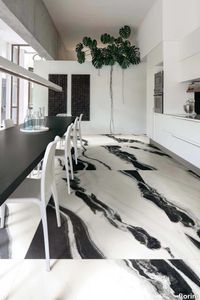
florim > Wall tile-stone-brick
Nature's sheer strength comes to life, white and black find new forms of expression Inspired by the different morphologies formed by the visceral movement of the earth, the collection's large slabs embrace and explore the concept of light-absence of light by presenting a chromatic gradient based on white and black in a multi-faceted graphic proposal that joins the two monochromatic surfaces, White and Black. Soft, sinuous shapes contrast with those more rigid and geometric, coming to life from the different proportions with which the white and black combine on the surface.
B&W_Marble Flow

florim > Wall tile-stone-brick
Nature's sheer strength comes to life, white and black find new forms of expression Inspired by the different morphologies formed by the visceral movement of the earth, the collection's large slabs embrace and explore the concept of light-absence of light by presenting a chromatic gradient based on white and black in a multi-faceted graphic proposal that joins the two monochromatic surfaces, White and Black. Soft, sinuous shapes contrast with those more rigid and geometric, coming to life from the different proportions with which the white and black combine on the surface.
B&W_Marble Fall

florim > Wall tile-stone-brick
Nature's sheer strength comes to life, white and black find new forms of expression Inspired by the different morphologies formed by the visceral movement of the earth, the collection's large slabs embrace and explore the concept of light-absence of light by presenting a chromatic gradient based on white and black in a multi-faceted graphic proposal that joins the two monochromatic surfaces, White and Black. Soft, sinuous shapes contrast with those more rigid and geometric, coming to life from the different proportions with which the white and black combine on the surface.
B&W_Marble Pebble

florim > Wall tile-stone-brick
Nature's sheer strength comes to life, white and black find new forms of expression Inspired by the different morphologies formed by the visceral movement of the earth, the collection's large slabs embrace and explore the concept of light-absence of light by presenting a chromatic gradient based on white and black in a multi-faceted graphic proposal that joins the two monochromatic surfaces, White and Black. Soft, sinuous shapes contrast with those more rigid and geometric, coming to life from the different proportions with which the white and black combine on the surface.
B&W_Marble Wave

florim > Wall tile-stone-brick
Nature's sheer strength comes to life, white and black find new forms of expression Inspired by the different morphologies formed by the visceral movement of the earth, the collection's large slabs embrace and explore the concept of light-absence of light by presenting a chromatic gradient based on white and black in a multi-faceted graphic proposal that joins the two monochromatic surfaces, White and Black. Soft, sinuous shapes contrast with those more rigid and geometric, coming to life from the different proportions with which the white and black combine on the surface.
B&W_Marble Breach

florim > Wall tile-stone-brick
Nature's sheer strength comes to life, white and black find new forms of expression Inspired by the different morphologies formed by the visceral movement of the earth, the collection's large slabs embrace and explore the concept of light-absence of light by presenting a chromatic gradient based on white and black in a multi-faceted graphic proposal that joins the two monochromatic surfaces, White and Black. Soft, sinuous shapes contrast with those more rigid and geometric, coming to life from the different proportions with which the white and black combine on the surface.
Chimera Empatia Nero
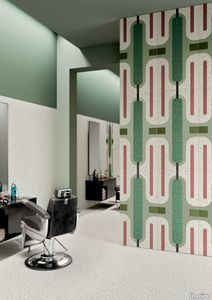
florim > Wall tile-stone-brick
In <em>Chimera,</em> Elena Salmistraro merges rigour with self-expression, in a graphic grammar laden with symbolic meaning. <em>Empatia </em>speaks to the emotions with graphics that interpret, through a highly individual abstract code, the stage make-up of a clown, with the aid of superimposed geometric forms and images. <em>Radici </em>is a tribal statement, a tribute to primitive ritual custom, evoked by the interplay between a sequence of triangles and rectangles and a set of figurative fragments. <em>Ritmo</em> is inspired by fabrics, suggesting the rhythmic alternation of woven yarns through a largely linear pattern. In <em>Colore, </em>the upheaval of a background of small isolated spots generated by a parametric digital program is combined with densely packed repeated forms. "The Chimera collection is rather like a book with four different chapters: I set out to differentiate these graphic motifs to create four totally different stories."<br></br>Elena Salmistraro It all starts with drawing. A <em>passion</em> for drawing. An <em>obsession</em> with drawing. Drawings like spider-webs, obsessively filling spaces, in a kind of manual choreography or gymnastics, a continuous flow. Elena Salmistraro draws all the time. She draws everywhere. Mostly on loose sheets or random surfaces. First and foremost with pen and pencil. Her drawings only acquire colour at a later stage. Often - just like Alessandro Mendini used to do - she draws "monsters": fascinating yet disturbing, subversive forms. The denser, more contorted the shape, the more obvious its underlying truth. For Elena, drawing is an intimate act. It is relaxing. And therapeutic. With an unrivalled communicative strength. Because drawing gives shape to ideas: you both give form to the world and reveal yourself. This passion, combined with natural graphic talent, has guided Elena Salmistraro in her project for Cedit: an experimental series of ceramic slabs produced using a high-definition 3D decorative technique. The explicit aim is to transform surfaces beyond their original flatness so that a new, visual and tactile, three-dimensional personality emerges, sweeping aside the coldness and uniformity that ceramic objects often inevitably convey.Elena Salmistraro has always viewed ceramics as a democratic material, in view of their accessibility, and the infinite potentials for shaping matter that they provide. She began working and experimenting with ceramics very early in her career, just after she graduated from the Milan Politecnico in 2008. She came into contact with small artistic craft firms specialising in smallproduction lots, and cut her teeth on projects that demanded the hand-processing of every detail, and finishes of high artistic value, for the high end of the market. The large corporations and galleries came later, but here again Elena kept faith with her desire to make mass-produced pieces unique, and to combine artistic value with specifically industrial characteristics. The monkey-shaped <em>Primates</em> vases reflect this method and intention, aiming to excite, surprise and charm. Antiminimalist and hyper-figurative, playful, ironic and a rich image-maker, often drawing on anthropology and magic, over the years Salmistraro has built up her own fantastic universe, inhabited by ceramic bestiaries, painted jungles and a cabinet like a one-eyed cyclops , always finding inspiration and inputs in nature and always aiming to reveal the extraordinary in the everyday. Given this background, it was almost inevitable she would work with Cedit: constantly seeking new talents and new approaches, as well as designs that break down the boundaries of ceramics and release them into the realm of art and innovation, the Modena company has recognised Elena Salmistraro as a leading contemporary creative spirit and involved her in a project intended to experiment with fresh ideas in materials and synaesthetics.Salmistraro's collection for Cedit is entitled <em>Chimera</em> and consists of large ceramic slabs, which can be enjoyed not only visually, through their patterns and colours, but also on a tactile level. Like the chimera in the "grotesque" tradition, monstrous in the etymological sense of the word with its merging of hybrid animal and vegetable shapes, the Cedit project attempts to originate a synaesthetic form of ceramics, through a three-dimensional development that exactly reproduces the texture of leathers and fabrics, creating an absolutely new kind of layered effect, with a tactile awareness that recalls the passion of grand master Ettore Sottsass for "surfaces that talk". And the surfaces of the slabs Salmistraro has created really seem to talk: in <em>Empatia </em>clown faces add theatricality to the cold gleam of marbles, interspersed with references to Art Déco graphics; <em>Radici</em> uses the textures of leathers and hide as if to re-establish a link between ceramics and other materials at the origins of human activity and creativity; in <em>Ritmo</em> the texture of cloth dialogues with pottery, almost in homage to the tactile rationalism of warp and weft, of which Bauhaus pioneer Anni Albers was one of the most expressive past interpreters ; finally, <em>Colore</em> has a spotted base generated by computer to underline the contrast between analogue and digital, the graphic sign and the matter into which it is impressed. It is an aesthetic of superimposition and mixing, and especially of synaesthesia: as in her drawings, in the <em>Chimera </em>slabs Elena Salmistraro's art is one of movement and acceleration. A process not of representation but of exploration. Of the world and of oneself. Almost a kind of Zen, for distancing oneself from the world to understand it more fully. In every sense.
Chimera Empatia Bianco

florim > Wall tile-stone-brick
In <em>Chimera,</em> Elena Salmistraro merges rigour with self-expression, in a graphic grammar laden with symbolic meaning. <em>Empatia </em>speaks to the emotions with graphics that interpret, through a highly individual abstract code, the stage make-up of a clown, with the aid of superimposed geometric forms and images. <em>Radici </em>is a tribal statement, a tribute to primitive ritual custom, evoked by the interplay between a sequence of triangles and rectangles and a set of figurative fragments. <em>Ritmo</em> is inspired by fabrics, suggesting the rhythmic alternation of woven yarns through a largely linear pattern. In <em>Colore, </em>the upheaval of a background of small isolated spots generated by a parametric digital program is combined with densely packed repeated forms. "The Chimera collection is rather like a book with four different chapters: I set out to differentiate these graphic motifs to create four totally different stories."<br></br>Elena Salmistraro It all starts with drawing. A <em>passion</em> for drawing. An <em>obsession</em> with drawing. Drawings like spider-webs, obsessively filling spaces, in a kind of manual choreography or gymnastics, a continuous flow. Elena Salmistraro draws all the time. She draws everywhere. Mostly on loose sheets or random surfaces. First and foremost with pen and pencil. Her drawings only acquire colour at a later stage. Often - just like Alessandro Mendini used to do - she draws "monsters": fascinating yet disturbing, subversive forms. The denser, more contorted the shape, the more obvious its underlying truth. For Elena, drawing is an intimate act. It is relaxing. And therapeutic. With an unrivalled communicative strength. Because drawing gives shape to ideas: you both give form to the world and reveal yourself. This passion, combined with natural graphic talent, has guided Elena Salmistraro in her project for Cedit: an experimental series of ceramic slabs produced using a high-definition 3D decorative technique. The explicit aim is to transform surfaces beyond their original flatness so that a new, visual and tactile, three-dimensional personality emerges, sweeping aside the coldness and uniformity that ceramic objects often inevitably convey.Elena Salmistraro has always viewed ceramics as a democratic material, in view of their accessibility, and the infinite potentials for shaping matter that they provide. She began working and experimenting with ceramics very early in her career, just after she graduated from the Milan Politecnico in 2008. She came into contact with small artistic craft firms specialising in smallproduction lots, and cut her teeth on projects that demanded the hand-processing of every detail, and finishes of high artistic value, for the high end of the market. The large corporations and galleries came later, but here again Elena kept faith with her desire to make mass-produced pieces unique, and to combine artistic value with specifically industrial characteristics. The monkey-shaped <em>Primates</em> vases reflect this method and intention, aiming to excite, surprise and charm. Antiminimalist and hyper-figurative, playful, ironic and a rich image-maker, often drawing on anthropology and magic, over the years Salmistraro has built up her own fantastic universe, inhabited by ceramic bestiaries, painted jungles and a cabinet like a one-eyed cyclops , always finding inspiration and inputs in nature and always aiming to reveal the extraordinary in the everyday. Given this background, it was almost inevitable she would work with Cedit: constantly seeking new talents and new approaches, as well as designs that break down the boundaries of ceramics and release them into the realm of art and innovation, the Modena company has recognised Elena Salmistraro as a leading contemporary creative spirit and involved her in a project intended to experiment with fresh ideas in materials and synaesthetics.Salmistraro's collection for Cedit is entitled <em>Chimera</em> and consists of large ceramic slabs, which can be enjoyed not only visually, through their patterns and colours, but also on a tactile level. Like the chimera in the "grotesque" tradition, monstrous in the etymological sense of the word with its merging of hybrid animal and vegetable shapes, the Cedit project attempts to originate a synaesthetic form of ceramics, through a three-dimensional development that exactly reproduces the texture of leathers and fabrics, creating an absolutely new kind of layered effect, with a tactile awareness that recalls the passion of grand master Ettore Sottsass for "surfaces that talk". And the surfaces of the slabs Salmistraro has created really seem to talk: in <em>Empatia </em>clown faces add theatricality to the cold gleam of marbles, interspersed with references to Art Déco graphics; <em>Radici</em> uses the textures of leathers and hide as if to re-establish a link between ceramics and other materials at the origins of human activity and creativity; in <em>Ritmo</em> the texture of cloth dialogues with pottery, almost in homage to the tactile rationalism of warp and weft, of which Bauhaus pioneer Anni Albers was one of the most expressive past interpreters ; finally, <em>Colore</em> has a spotted base generated by computer to underline the contrast between analogue and digital, the graphic sign and the matter into which it is impressed. It is an aesthetic of superimposition and mixing, and especially of synaesthesia: as in her drawings, in the <em>Chimera </em>slabs Elena Salmistraro's art is one of movement and acceleration. A process not of representation but of exploration. Of the world and of oneself. Almost a kind of Zen, for distancing oneself from the world to understand it more fully. In every sense.
Compatta Pisé Ghiaia
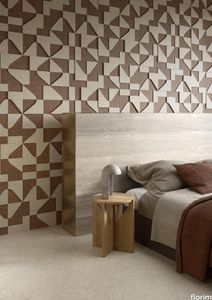
florim > Wall tile-stone-brick
<p>A passion for earth as a natural material and for rammed earth, an ancient construction technique.</p> <p>The combination of these patterns evolves into the concept of Pisé Inserti, more slabs of immense decorative impact, generated by the two-dimensional criss-crossing of exquisite, rounded geometrical forms: the designer combines the natural earthen shades with apparently random curved lines that evoke the uneven trapezia with rounded corners used by Gio Ponti.</p> <p>These are also available in the large 120x280 cm size and 6 mm thickness in three variants: Pisé Inserti A, Pisé Inserti B and Pisé Inserti C. COMPATTA’s potential is further enhanced by three-dimensional subjects of varying shapes, which can be built up into mesh-backed mosaics to create sculptural forms on walls. These extensions to the collection are called Inserti Melange, Inserti Sabbia-Argilla and Inserti Limo-Ghiaia and are produced in 9 mm thickness and 30x30 cm size.</p> <p>The collection is born from a sustainable and virtuous approach and is part of <a href="https://www.florim.com/en/company/sustainability/carbonzero-florim/">CarbonZero</a>, Florim's range of Carbon Neutral surfaces.</p> <p>The COMPATTA collection, designed by Federico Peri, combines a passion for earth as a natural material and an interest in a very ancient construction technique.<br>The primary inspiration derives from close observation of the many strata within the ground and the mixtures of elementary particles of which it consists. The design concept is completed by reference to the age-old rammed earth construction technique, used in northern Jordan since the eighth millennium BCE and widely applied in Yemen in many other desert or rural settings until the mid 19thC.<br>In this method, the raw earth is compacted inside wooden formwork to construct continuous structural walls, bearing walls or partitions inside homes, with a natural decorative effect due to the layering of the different shades of clay used. When creating his project for CEDIT, Peri was also influenced by several design inputs: from rural African homes to the clear, simple geometric forms and curved lines typical of the work of Gio Ponti, the curves central to the modernist gardens of Brazilian landscape artist Roberto Burle Marx, and the three-dimensional mosaics of English sculptor William Mitchell. In his murals in concrete, glass and recycled materials, Mitchell seems to combine some of the typical features of a variety of artistic movements, from Modernism to Brutalism, and also shows awareness of the issues concerning the structure of the landscape and the relationship with nature at the heart of Land Art. COMPATTA thus embodies strong links to the world of art and architecture, while bringing natural impressions with a remote, primitive flavour into modern living-spaces.</p>
Compatta Ghiaia

florim > Wall tile-stone-brick
<p>A passion for earth as a natural material and for rammed earth, an ancient construction technique.</p> <p>The combination of these patterns evolves into the concept of Pisé Inserti, more slabs of immense decorative impact, generated by the two-dimensional criss-crossing of exquisite, rounded geometrical forms: the designer combines the natural earthen shades with apparently random curved lines that evoke the uneven trapezia with rounded corners used by Gio Ponti.</p> <p>These are also available in the large 120x280 cm size and 6 mm thickness in three variants: Pisé Inserti A, Pisé Inserti B and Pisé Inserti C. COMPATTA’s potential is further enhanced by three-dimensional subjects of varying shapes, which can be built up into mesh-backed mosaics to create sculptural forms on walls. These extensions to the collection are called Inserti Melange, Inserti Sabbia-Argilla and Inserti Limo-Ghiaia and are produced in 9 mm thickness and 30x30 cm size.</p> <p>The collection is born from a sustainable and virtuous approach and is part of <a href="https://www.florim.com/en/company/sustainability/carbonzero-florim/">CarbonZero</a>, Florim's range of Carbon Neutral surfaces.</p> <p>The COMPATTA collection, designed by Federico Peri, combines a passion for earth as a natural material and an interest in a very ancient construction technique.<br>The primary inspiration derives from close observation of the many strata within the ground and the mixtures of elementary particles of which it consists. The design concept is completed by reference to the age-old rammed earth construction technique, used in northern Jordan since the eighth millennium BCE and widely applied in Yemen in many other desert or rural settings until the mid 19thC.<br>In this method, the raw earth is compacted inside wooden formwork to construct continuous structural walls, bearing walls or partitions inside homes, with a natural decorative effect due to the layering of the different shades of clay used. When creating his project for CEDIT, Peri was also influenced by several design inputs: from rural African homes to the clear, simple geometric forms and curved lines typical of the work of Gio Ponti, the curves central to the modernist gardens of Brazilian landscape artist Roberto Burle Marx, and the three-dimensional mosaics of English sculptor William Mitchell. In his murals in concrete, glass and recycled materials, Mitchell seems to combine some of the typical features of a variety of artistic movements, from Modernism to Brutalism, and also shows awareness of the issues concerning the structure of the landscape and the relationship with nature at the heart of Land Art. COMPATTA thus embodies strong links to the world of art and architecture, while bringing natural impressions with a remote, primitive flavour into modern living-spaces.</p>
Compatta Argilla

florim > Wall tile-stone-brick
<p>A passion for earth as a natural material and for rammed earth, an ancient construction technique.</p> <p>The combination of these patterns evolves into the concept of Pisé Inserti, more slabs of immense decorative impact, generated by the two-dimensional criss-crossing of exquisite, rounded geometrical forms: the designer combines the natural earthen shades with apparently random curved lines that evoke the uneven trapezia with rounded corners used by Gio Ponti.</p> <p>These are also available in the large 120x280 cm size and 6 mm thickness in three variants: Pisé Inserti A, Pisé Inserti B and Pisé Inserti C. COMPATTA’s potential is further enhanced by three-dimensional subjects of varying shapes, which can be built up into mesh-backed mosaics to create sculptural forms on walls. These extensions to the collection are called Inserti Melange, Inserti Sabbia-Argilla and Inserti Limo-Ghiaia and are produced in 9 mm thickness and 30x30 cm size.</p> <p>The collection is born from a sustainable and virtuous approach and is part of <a href="https://www.florim.com/en/company/sustainability/carbonzero-florim/">CarbonZero</a>, Florim's range of Carbon Neutral surfaces.</p> <p>The COMPATTA collection, designed by Federico Peri, combines a passion for earth as a natural material and an interest in a very ancient construction technique.<br>The primary inspiration derives from close observation of the many strata within the ground and the mixtures of elementary particles of which it consists. The design concept is completed by reference to the age-old rammed earth construction technique, used in northern Jordan since the eighth millennium BCE and widely applied in Yemen in many other desert or rural settings until the mid 19thC.<br>In this method, the raw earth is compacted inside wooden formwork to construct continuous structural walls, bearing walls or partitions inside homes, with a natural decorative effect due to the layering of the different shades of clay used. When creating his project for CEDIT, Peri was also influenced by several design inputs: from rural African homes to the clear, simple geometric forms and curved lines typical of the work of Gio Ponti, the curves central to the modernist gardens of Brazilian landscape artist Roberto Burle Marx, and the three-dimensional mosaics of English sculptor William Mitchell. In his murals in concrete, glass and recycled materials, Mitchell seems to combine some of the typical features of a variety of artistic movements, from Modernism to Brutalism, and also shows awareness of the issues concerning the structure of the landscape and the relationship with nature at the heart of Land Art. COMPATTA thus embodies strong links to the world of art and architecture, while bringing natural impressions with a remote, primitive flavour into modern living-spaces.</p>
Compatta Pisé Melange

florim > Wall tile-stone-brick
<p>A passion for earth as a natural material and for rammed earth, an ancient construction technique.</p> <p>The combination of these patterns evolves into the concept of Pisé Inserti, more slabs of immense decorative impact, generated by the two-dimensional criss-crossing of exquisite, rounded geometrical forms: the designer combines the natural earthen shades with apparently random curved lines that evoke the uneven trapezia with rounded corners used by Gio Ponti.</p> <p>These are also available in the large 120x280 cm size and 6 mm thickness in three variants: Pisé Inserti A, Pisé Inserti B and Pisé Inserti C. COMPATTA’s potential is further enhanced by three-dimensional subjects of varying shapes, which can be built up into mesh-backed mosaics to create sculptural forms on walls. These extensions to the collection are called Inserti Melange, Inserti Sabbia-Argilla and Inserti Limo-Ghiaia and are produced in 9 mm thickness and 30x30 cm size.</p> <p>The collection is born from a sustainable and virtuous approach and is part of <a href="https://www.florim.com/en/company/sustainability/carbonzero-florim/">CarbonZero</a>, Florim's range of Carbon Neutral surfaces.</p> <p>The COMPATTA collection, designed by Federico Peri, combines a passion for earth as a natural material and an interest in a very ancient construction technique.<br>The primary inspiration derives from close observation of the many strata within the ground and the mixtures of elementary particles of which it consists. The design concept is completed by reference to the age-old rammed earth construction technique, used in northern Jordan since the eighth millennium BCE and widely applied in Yemen in many other desert or rural settings until the mid 19thC.<br>In this method, the raw earth is compacted inside wooden formwork to construct continuous structural walls, bearing walls or partitions inside homes, with a natural decorative effect due to the layering of the different shades of clay used. When creating his project for CEDIT, Peri was also influenced by several design inputs: from rural African homes to the clear, simple geometric forms and curved lines typical of the work of Gio Ponti, the curves central to the modernist gardens of Brazilian landscape artist Roberto Burle Marx, and the three-dimensional mosaics of English sculptor William Mitchell. In his murals in concrete, glass and recycled materials, Mitchell seems to combine some of the typical features of a variety of artistic movements, from Modernism to Brutalism, and also shows awareness of the issues concerning the structure of the landscape and the relationship with nature at the heart of Land Art. COMPATTA thus embodies strong links to the world of art and architecture, while bringing natural impressions with a remote, primitive flavour into modern living-spaces.</p>
Compatta Pisé Sabbia

florim > Wall tile-stone-brick
<p>A passion for earth as a natural material and for rammed earth, an ancient construction technique.</p> <p>The combination of these patterns evolves into the concept of Pisé Inserti, more slabs of immense decorative impact, generated by the two-dimensional criss-crossing of exquisite, rounded geometrical forms: the designer combines the natural earthen shades with apparently random curved lines that evoke the uneven trapezia with rounded corners used by Gio Ponti.</p> <p>These are also available in the large 120x280 cm size and 6 mm thickness in three variants: Pisé Inserti A, Pisé Inserti B and Pisé Inserti C. COMPATTA’s potential is further enhanced by three-dimensional subjects of varying shapes, which can be built up into mesh-backed mosaics to create sculptural forms on walls. These extensions to the collection are called Inserti Melange, Inserti Sabbia-Argilla and Inserti Limo-Ghiaia and are produced in 9 mm thickness and 30x30 cm size.</p> <p>The collection is born from a sustainable and virtuous approach and is part of <a href="https://www.florim.com/en/company/sustainability/carbonzero-florim/">CarbonZero</a>, Florim's range of Carbon Neutral surfaces.</p> <p>The COMPATTA collection, designed by Federico Peri, combines a passion for earth as a natural material and an interest in a very ancient construction technique.<br>The primary inspiration derives from close observation of the many strata within the ground and the mixtures of elementary particles of which it consists. The design concept is completed by reference to the age-old rammed earth construction technique, used in northern Jordan since the eighth millennium BCE and widely applied in Yemen in many other desert or rural settings until the mid 19thC.<br>In this method, the raw earth is compacted inside wooden formwork to construct continuous structural walls, bearing walls or partitions inside homes, with a natural decorative effect due to the layering of the different shades of clay used. When creating his project for CEDIT, Peri was also influenced by several design inputs: from rural African homes to the clear, simple geometric forms and curved lines typical of the work of Gio Ponti, the curves central to the modernist gardens of Brazilian landscape artist Roberto Burle Marx, and the three-dimensional mosaics of English sculptor William Mitchell. In his murals in concrete, glass and recycled materials, Mitchell seems to combine some of the typical features of a variety of artistic movements, from Modernism to Brutalism, and also shows awareness of the issues concerning the structure of the landscape and the relationship with nature at the heart of Land Art. COMPATTA thus embodies strong links to the world of art and architecture, while bringing natural impressions with a remote, primitive flavour into modern living-spaces.</p>
Compatta Sabbia

florim > Wall tile-stone-brick
<p>A passion for earth as a natural material and for rammed earth, an ancient construction technique.</p> <p>The combination of these patterns evolves into the concept of Pisé Inserti, more slabs of immense decorative impact, generated by the two-dimensional criss-crossing of exquisite, rounded geometrical forms: the designer combines the natural earthen shades with apparently random curved lines that evoke the uneven trapezia with rounded corners used by Gio Ponti.</p> <p>These are also available in the large 120x280 cm size and 6 mm thickness in three variants: Pisé Inserti A, Pisé Inserti B and Pisé Inserti C. COMPATTA’s potential is further enhanced by three-dimensional subjects of varying shapes, which can be built up into mesh-backed mosaics to create sculptural forms on walls. These extensions to the collection are called Inserti Melange, Inserti Sabbia-Argilla and Inserti Limo-Ghiaia and are produced in 9 mm thickness and 30x30 cm size.</p> <p>The collection is born from a sustainable and virtuous approach and is part of <a href="https://www.florim.com/en/company/sustainability/carbonzero-florim/">CarbonZero</a>, Florim's range of Carbon Neutral surfaces.</p> <p>The COMPATTA collection, designed by Federico Peri, combines a passion for earth as a natural material and an interest in a very ancient construction technique.<br>The primary inspiration derives from close observation of the many strata within the ground and the mixtures of elementary particles of which it consists. The design concept is completed by reference to the age-old rammed earth construction technique, used in northern Jordan since the eighth millennium BCE and widely applied in Yemen in many other desert or rural settings until the mid 19thC.<br>In this method, the raw earth is compacted inside wooden formwork to construct continuous structural walls, bearing walls or partitions inside homes, with a natural decorative effect due to the layering of the different shades of clay used. When creating his project for CEDIT, Peri was also influenced by several design inputs: from rural African homes to the clear, simple geometric forms and curved lines typical of the work of Gio Ponti, the curves central to the modernist gardens of Brazilian landscape artist Roberto Burle Marx, and the three-dimensional mosaics of English sculptor William Mitchell. In his murals in concrete, glass and recycled materials, Mitchell seems to combine some of the typical features of a variety of artistic movements, from Modernism to Brutalism, and also shows awareness of the issues concerning the structure of the landscape and the relationship with nature at the heart of Land Art. COMPATTA thus embodies strong links to the world of art and architecture, while bringing natural impressions with a remote, primitive flavour into modern living-spaces.</p>
Compatta Pisé Limo

florim > Wall tile-stone-brick
<p>A passion for earth as a natural material and for rammed earth, an ancient construction technique.</p> <p>The combination of these patterns evolves into the concept of Pisé Inserti, more slabs of immense decorative impact, generated by the two-dimensional criss-crossing of exquisite, rounded geometrical forms: the designer combines the natural earthen shades with apparently random curved lines that evoke the uneven trapezia with rounded corners used by Gio Ponti.</p> <p>These are also available in the large 120x280 cm size and 6 mm thickness in three variants: Pisé Inserti A, Pisé Inserti B and Pisé Inserti C. COMPATTA’s potential is further enhanced by three-dimensional subjects of varying shapes, which can be built up into mesh-backed mosaics to create sculptural forms on walls. These extensions to the collection are called Inserti Melange, Inserti Sabbia-Argilla and Inserti Limo-Ghiaia and are produced in 9 mm thickness and 30x30 cm size.</p> <p>The collection is born from a sustainable and virtuous approach and is part of <a href="https://www.florim.com/en/company/sustainability/carbonzero-florim/">CarbonZero</a>, Florim's range of Carbon Neutral surfaces.</p> <p>The COMPATTA collection, designed by Federico Peri, combines a passion for earth as a natural material and an interest in a very ancient construction technique.<br>The primary inspiration derives from close observation of the many strata within the ground and the mixtures of elementary particles of which it consists. The design concept is completed by reference to the age-old rammed earth construction technique, used in northern Jordan since the eighth millennium BCE and widely applied in Yemen in many other desert or rural settings until the mid 19thC.<br>In this method, the raw earth is compacted inside wooden formwork to construct continuous structural walls, bearing walls or partitions inside homes, with a natural decorative effect due to the layering of the different shades of clay used. When creating his project for CEDIT, Peri was also influenced by several design inputs: from rural African homes to the clear, simple geometric forms and curved lines typical of the work of Gio Ponti, the curves central to the modernist gardens of Brazilian landscape artist Roberto Burle Marx, and the three-dimensional mosaics of English sculptor William Mitchell. In his murals in concrete, glass and recycled materials, Mitchell seems to combine some of the typical features of a variety of artistic movements, from Modernism to Brutalism, and also shows awareness of the issues concerning the structure of the landscape and the relationship with nature at the heart of Land Art. COMPATTA thus embodies strong links to the world of art and architecture, while bringing natural impressions with a remote, primitive flavour into modern living-spaces.</p>
Compatta Limo

florim > Wall tile-stone-brick
<p>A passion for earth as a natural material and for rammed earth, an ancient construction technique.</p> <p>The combination of these patterns evolves into the concept of Pisé Inserti, more slabs of immense decorative impact, generated by the two-dimensional criss-crossing of exquisite, rounded geometrical forms: the designer combines the natural earthen shades with apparently random curved lines that evoke the uneven trapezia with rounded corners used by Gio Ponti.</p> <p>These are also available in the large 120x280 cm size and 6 mm thickness in three variants: Pisé Inserti A, Pisé Inserti B and Pisé Inserti C. COMPATTA’s potential is further enhanced by three-dimensional subjects of varying shapes, which can be built up into mesh-backed mosaics to create sculptural forms on walls. These extensions to the collection are called Inserti Melange, Inserti Sabbia-Argilla and Inserti Limo-Ghiaia and are produced in 9 mm thickness and 30x30 cm size.</p> <p>The collection is born from a sustainable and virtuous approach and is part of <a href="https://www.florim.com/en/company/sustainability/carbonzero-florim/">CarbonZero</a>, Florim's range of Carbon Neutral surfaces.</p> <p>The COMPATTA collection, designed by Federico Peri, combines a passion for earth as a natural material and an interest in a very ancient construction technique.<br>The primary inspiration derives from close observation of the many strata within the ground and the mixtures of elementary particles of which it consists. The design concept is completed by reference to the age-old rammed earth construction technique, used in northern Jordan since the eighth millennium BCE and widely applied in Yemen in many other desert or rural settings until the mid 19thC.<br>In this method, the raw earth is compacted inside wooden formwork to construct continuous structural walls, bearing walls or partitions inside homes, with a natural decorative effect due to the layering of the different shades of clay used. When creating his project for CEDIT, Peri was also influenced by several design inputs: from rural African homes to the clear, simple geometric forms and curved lines typical of the work of Gio Ponti, the curves central to the modernist gardens of Brazilian landscape artist Roberto Burle Marx, and the three-dimensional mosaics of English sculptor William Mitchell. In his murals in concrete, glass and recycled materials, Mitchell seems to combine some of the typical features of a variety of artistic movements, from Modernism to Brutalism, and also shows awareness of the issues concerning the structure of the landscape and the relationship with nature at the heart of Land Art. COMPATTA thus embodies strong links to the world of art and architecture, while bringing natural impressions with a remote, primitive flavour into modern living-spaces.</p>
Coretech Flame Dark
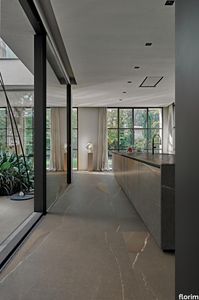
florim > Wall tile-stone-brick
<p>Florim’s Coretech collection takes Piasentina stone quarried in the foothills of the Julian Alps and enhances its performance to cater to the needs of contemporary architecture.</p> <p>Piasentina stone is ideally suited to the creation of relief textures and finishes using traditional methods and age-old techniques.<br>Different types of processing give different colours and feels to this natural stone, thus making it possible to put together numerous combinations using the same material. </p> <p>Piasentina stone’s name means “pleasing stone” in Friulian. It has been known since ancient Roman times and it is now highly sought after in architecture in Italy and internationally due to the shades of colour and versatility it can offer indoors and outdoors, on both urban floors and walls.</p> <p><br>It stands out not only due to its distinctive feel but also thanks to its refined <strong>grey tones </strong>with slender white veins and little brownish tinges.</p> <p><br>It is a stone that can conjure up all sorts of emotional responses, making it a popular choice among interior designers and architects across the globe. It has played a central role in numerous constructions over the centuries, including churches, palaces, villas, rural buildings and flooring. It was used by figures such as the Renaissance master Andrea Palladio and Raimondo D’Aronco in the Art Nouveau period and it continues to be employed in 21st century architecture and design.</p>